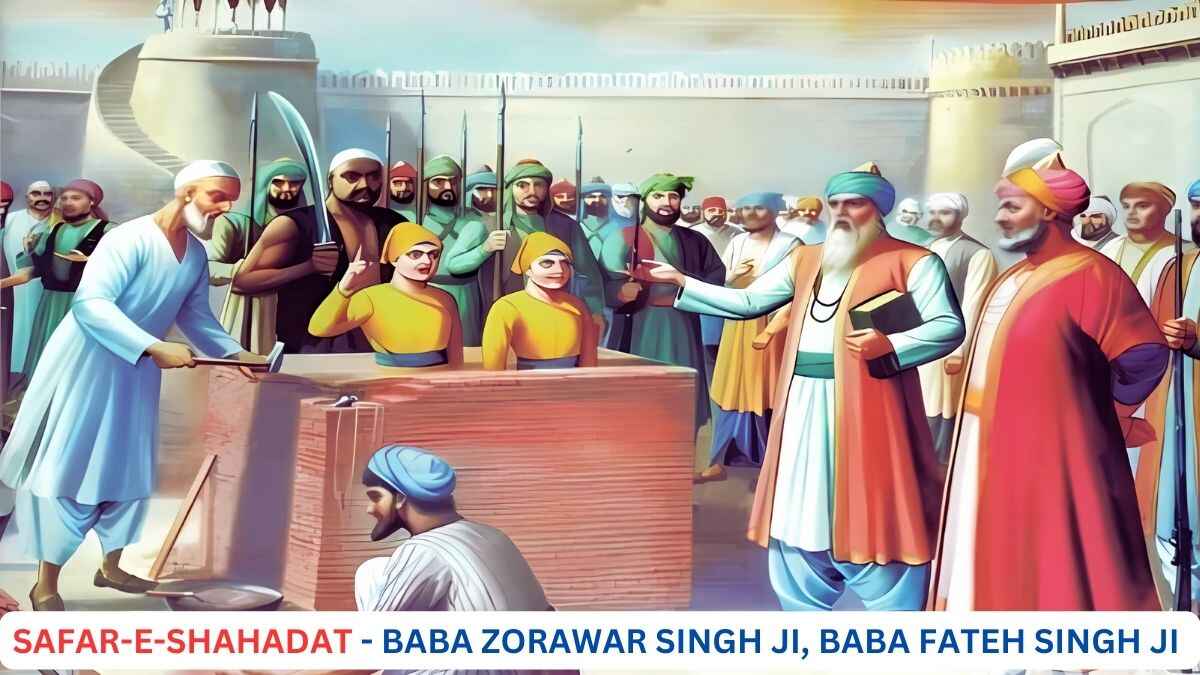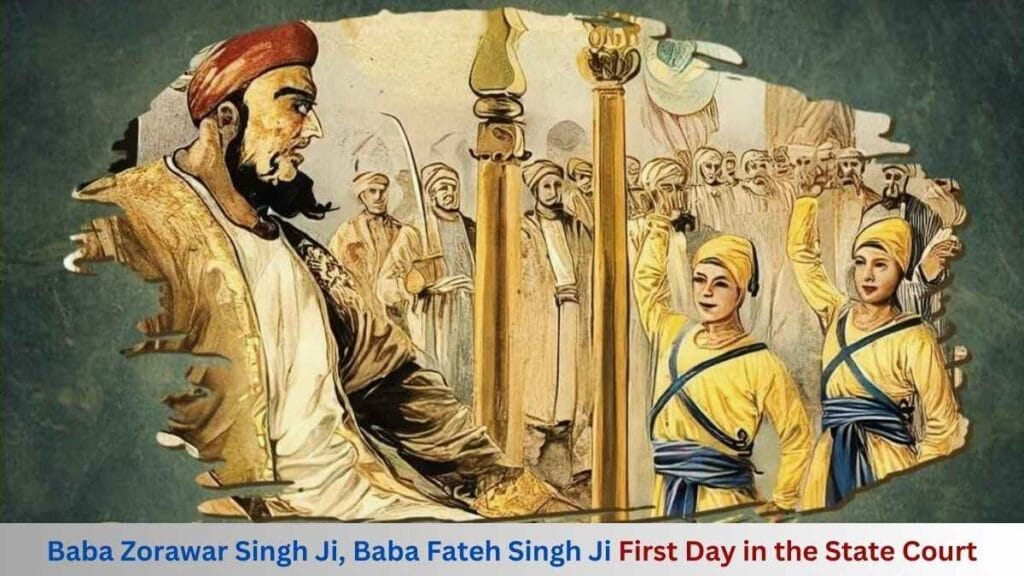The Martyrdom of Sahibzadas 12 Poh, Tribute to the Brave Sahibzadas
The martyrdom of the Sahibzadas on 12 Poh is a defining moment in Sikh history, a tale of unwavering faith and ultimate sacrifice. The Chaar Sahibzade, the four sons of Guru Gobind Singh Ji, dedicated their lives to upholding the values of Sikhism. Among them, Sahibzada Zorawar Singh and Sahibzada Fateh Singh, the younger sons of the Guru, displayed exceptional bravery in the face of persecution.
Their martyrdom, which took place in December 1704, remains an inspiration for millions. Every year, Sikhs across the world honor their memory, reflecting on their sacrifice and the lessons it imparts.
The Siege of Anandpur Sahib
In 1704, Anandpur Sahib, the stronghold of Guru Gobind Singh Ji, was besieged by the Mughal army and their allies. The prolonged siege led to scarcity of food and essentials, causing immense suffering for the Guru’s followers. Eventually, the Mughal forces promised safe passage if the Guru and his family evacuated the fort.
Trusting their word, Guru Gobind Singh Ji and his followers left Anandpur Sahib, only to be betrayed soon after. In the chaos that ensued, the Guru’s family was separated. Mata Gujri Ji and the younger Sahibzadas were captured and taken to Sirhind under the custody of Wazir Khan, the Nawab of Sirhind.
Also read: Why Hola Mohalla is Celebrated Its Importance in Sikhism
Imprisonment in the Cold Tower (Thanda Burj)
Upon reaching Sirhind, Mata Gujri Ji and the young Sahibzadas were imprisoned in the Thanda Burj, a freezing, open-air tower. The harsh winter winds and chilling cold failed to break their spirit. Despite being just nine and six years old, Sahibzada Zorawar Singh and Sahibzada Fateh Singh showed remarkable resilience. Under the guidance of Mata Gujri Ji, they remained firm in their faith, drawing strength from the teachings of Guru Nanak and Guru Gobind Singh Ji.
The Trial of the Sahibzadas
Wazir Khan, realizing the immense potential of the young Sahibzadas, sought to convert them to Islam. He offered them riches, power, and a life of luxury in exchange for renouncing Sikhism. However, the Sahibzadas, despite their young age, refused to abandon their faith. They boldly declared their allegiance to Sikhism, rejecting all temptations. Their unwavering stance infuriated Wazir Khan, who then sentenced them to execution.
The Brutal Martyrdom
On 12 Poh, the Sahibzadas were ordered to be bricked alive. The cruel punishment was meant to instill fear, yet the young sons of Guru Gobind Singh Ji remained composed. As the bricks were stacked around them, they continued reciting Gurbani, demonstrating their deep faith and unshakable courage. Eventually, when the wall collapsed, the executioners ruthlessly killed them. Their martyrdom shook the Sikh community and strengthened their resolve to fight oppression.
Mata Gujri Ji Sacrifice
Upon learning of her grandsons’ martyrdom, Mata Gujri Ji embraced death with grace. Her soul departed, joining the Sahibzadas in eternal peace. Her sacrifice, like that of the Sahibzadas, is remembered as a symbol of supreme devotion and faith.
Aftermath and Legacy
The martyrdom of the Sahibzadas sent shockwaves across Punjab. Their sacrifice fueled the determination of the Sikh community to resist tyranny. Gurdwara Fatehgarh Sahib now stands at the site of their martyrdom, serving as a place of pilgrimage and remembrance. The sacrifice of the Sahibzadas continues to inspire Sikhs to uphold righteousness and remain steadfast in their beliefs.
Commemoration and Significance
Every year, from December 24 to 26, Sikhs observe Shaheedi Jor Mela at Fatehgarh Sahib, honoring the martyrdom of the Sahibzadas and Mata Gujri Ji. Devotees gather to pay tribute, listen to sermons recounting their bravery, and participate in religious processions. The tale of their sacrifice is recited to instill values of courage, faith, and integrity in future generations.
The Importance of 12 Poh in Sikh History
The martyrdom of the Sahibzadas on 12 Poh is a crucial chapter in Sikh history. It is a reminder of the immense sacrifices made to preserve the principles of justice and righteousness. Their story continues to resonate with millions, inspiring them to stand for truth and unwavering faith in the face of adversity.
In Conclusion, The story of the Sahibzadas’ martyrdom is not just a historical event but a testament to the strength of faith and resilience. Their sacrifice remains an eternal source of inspiration for people across the world. The observance of 12 Poh serves as a time for reflection, remembrance, and recommitment to the values they upheld. Their legacy endures, ensuring that their bravery and faith continue to illuminate the path of righteousness for generations to come.
Also Read: British Indian Traveler’s Scathing Review of India’s Tourism
FAQs
Who were the Chaar Sahibzade?
The Chaar Sahibzade refers to the four sons of Guru Gobind Singh Ji: Sahibzada Ajit Singh, Jujhar Singh, Zorawar Singh, and Fateh Singh.
What is the significance of 12 Poh in Sikh history?
12 Poh marks the martyrdom of Sahibzada Zorawar Singh and Sahibzada Fateh Singh, who were executed for refusing to renounce their faith.
Where is Gurdwara Fatehgarh Sahib located?
Gurdwara Fatehgarh Sahib is in Sirhind, Punjab, India, at the site where the younger Sahibzadas were martyred.
How do Sikhs commemorate the martyrdom of the Sahibzadas?
Sikhs observe Shaheedi Jor Mela annually from December 24 to 26, engaging in prayers, processions, and recounting the tales of bravery of the Sahibzadas.
What lessons can be learned from the martyrdom of the Sahibzadas?
Their sacrifice imparts values of unwavering faith, courage in the face of adversity, and the importance of standing up for one’s beliefs.



